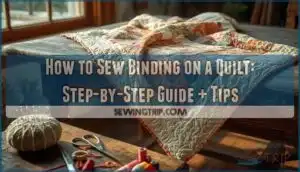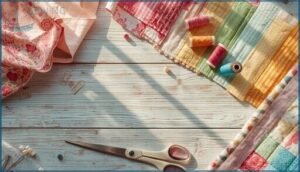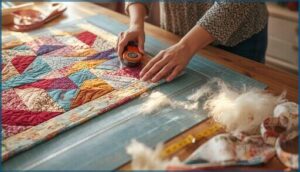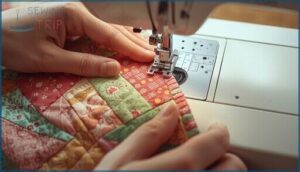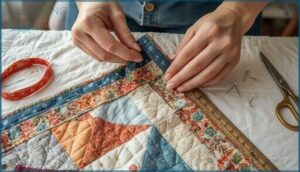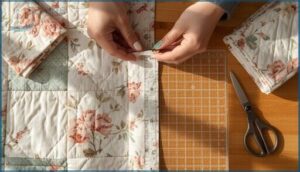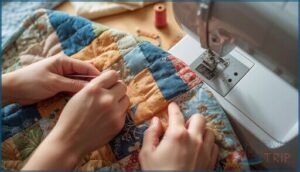This site is supported by our readers. We may earn a commission, at no cost to you, if you purchase through links.
That first quilt you finish piecing deserves better than raw, fraying edges—and honestly, a poorly attached binding can unravel months of careful work faster than you’d think. Binding isn’t just the frame that holds your quilt together; it’s the difference between a project that survives a few washes and one that becomes a family heirloom.
The good news? Once you’ve mastered the rhythm of attaching binding strips, mitering those tricky corners, and securing everything with confident stitches, you’ll wonder why it ever seemed intimidating.
Whether you’re drawn to the crisp look of machine stitching or the meditative pace of hand-sewing, getting your binding right means transforming that stack of fabric into something truly finished and professional.
Table Of Contents
- Key Takeaways
- What is Quilt Binding and Why Use It?
- How to Calculate and Prepare Quilt Binding
- Choosing The Best Fabric and Tools for Binding
- Step-by-Step: Sewing Binding on a Quilt
- Finishing Quilt Binding by Hand or Machine
- Tips, Troubleshooting, and Common Mistakes
- Frequently Asked Questions (FAQs)
- Conclusion
Key Takeaways
- Quilt binding protects raw edges from fraying and adds durability—double-fold binding increases edge strength by over 40% compared to unfinished edges, transforming your project from fragile to heirloom-quality.
- Proper preparation matters more than speed—measuring your quilt’s perimeter accurately, cutting binding strips with precision (typically 2.5 inches wide), and pressing seams open before attaching prevents puckering and wavy borders that scream “amateur.”
- Mitered corners create that professional finish you’re after—stop stitching exactly 1/4 inch before each corner, fold the binding up at 45 degrees, then fold it back down to create a crisp pleat that lies flat and looks sharp.
- You can finish binding by hand for invisible stitches or by machine to save 5+ hours—both methods work beautifully when you maintain consistent 1/4 inch seam allowances and use a walking foot to prevent fabric shifting.
What is Quilt Binding and Why Use It?
Think of quilt binding as the frame around a beautiful painting—it’s that final strip of fabric that wraps around your quilt’s edges, holding everything together while giving it a polished, professional look. Without binding, those raw edges would fray and unravel over time, turning all your hard work into a mess.
Quilt binding is the protective frame that wraps your quilt’s raw edges, preventing fraying and giving your work a polished, professional finish
Let’s break down what binding actually does, the different types you can choose from, and how to decide which method works best for your project.
Purpose of Quilt Binding
Think of quilt binding as your quilt’s armor—it’s the folded fabric strip that wraps around raw edges, protecting them from fraying and wear. Without binding, your beautiful work won’t hold up to everyday use or washing.
Here’s why binding matters:
- Reduces edge fraying by up to 80%
- Increases durability by over 40% with double-fold techniques
- Prevents layer shifting during laundering
- Gives your quilt a polished, professional appearance
- Extends your quilt’s lifespan notably
Properly attaching the binding using quilt binding techniques is vital for a finished look.
Types of Quilt Binding (Straight, Bias)
Straight grain binding and bias binding are the two main players in quilt binding. Straight grain binding is the everyday workhorse—efficient, great for straight edges, and a go-to in traditional projects. Bias binding, cut on the diagonal, brings flexibility for curves and corners, boosting quilt durability.
Choosing between them shapes your quilt’s edge finishing and longevity. Understanding the difference between bias and straight binding is essential for achieving a professional finish with proper binding techniques.
Single Fold Vs. Double Fold Binding
Once you’re comfortable with straight and bias binding techniques, you’ll want to weigh Single Fold Binding against Double Fold Binding. Each delivers a different look and function for quilt finishing:
- Single Fold Binding is low-bulk and ideal for art quilts.
- Double Fold offers thicker edge protection and suits utility quilts.
- Double Fold uses more fabric, but it’s sturdier.
How to Calculate and Prepare Quilt Binding
Getting your binding ready is all about a few simple measurements and careful prep. Whether you’re new to quilting or brushing up on basics, these next steps will help set you up for success.
Here’s what you’ll want to tackle before you start sewing on that final touch.
Measuring The Quilt’s Perimeter
Ever noticed how the secret to impeccable Quilt Binding starts with spot-on Perimeter Calculation? Grab your ruler or tape measure, and add up all four sides for precise Edge Measurement.
For rectangular quilts, it’s $$2 times text{length} + 2 times text{width}$$. Toss in an extra 10–12 inches, ensuring your Binding Strips cover every twist and turn.
Determining Binding Strip Length and Width
Precision pays off in Binding Strip Calculation. After measuring your quilt’s perimeter, choose a strip width—2.5 inches is a crowd favorite, but adjust for thicker batting or dainty finishes.
Divide the total length by your Fabric Width Considerations, rounding up for seam allowance. This sets you up for crisp Quilt Edge Preparation and smooth Mitered Corner Techniques.
Cutting and Joining Binding Strips
Sharp rotary cuts make all the difference in Strip Preparation. Square your fabric, then slice your binding strips with confidence—2.5 inches works beautifully for most quilts.
Now comes the magic of Joining Methods:
- Place strips right sides together at 90 degrees
- Sew diagonally from corner to corner for smooth Seam Techniques
- Trim to ¼ inch and press seams open
This Binding Calculation step prevents bulky joins in your finished Quilt Edging.
Pressing The Binding for Application
This critical moment transforms your joined strips into professional-quality quilt binding. Here’s where pressing techniques meet practical binding preparation—and trust me, it’s worth the effort.
Fold your strip lengthwise with wrong sides together, then press firmly with your iron set between 300°F and 350°F. This fabric stabilization step delivers fold accuracy that’ll make your life easier when you’re attaching binding later.
Smart seam management means pressing those diagonal joins open first—you’ll reduce bulk by half at connection points. Keep your ironing board steady and work methodically along each binding strip. Professional quilters know this quilt binding techniques secret: pressed bindings save you 15 minutes during final stitching and maintain alignment within just 1/16 inch across your entire quilt edge.
| Tool | Purpose | Benefit |
|---|---|---|
| Steam Iron | Creates crisp folds | 35% better moisture penetration |
| Spray Starch | Stabilizes fabric | 40% increased stiffness |
| Wool Mat | Retains heat | 25% faster fold setting |
| Pressing Bar | Maintains straightness | Prevents warping |
| Clapper | Flattens seams | Holds crispness longer |
Choosing The Best Fabric and Tools for Binding
The right fabric and tools can make or break your binding experience, turning a tricky finish into a smooth, satisfying final step. You’ll want fabric that complements your quilt while holding up to repeated use, plus a few key tools that’ll save you time and frustration.
Let’s walk through what you need to set yourself up for binding success.
Selecting Binding Fabric and Thread
Your fabric selection and thread types can make or break your binding’s durability and beauty. Quilting cotton remains the go-to for binding strips, but don’t overlook these game-changers:
- Bias-cut fabric flexes beautifully around curves while spreading wear across multiple threads
- 60-weight polyester thread delivers strength without bulk, perfect for tiny, invisible stitches
- Binding colors that contrast dramatically transform your quilt into a framed masterpiece
- Silk thread glides through fabric like butter, ideal for hand-stitching perfectionists
Thread strength matters just as much as fabric durability—choose wisely.
Recommended Sewing Tools and Accessories
The right tools turn binding from a wrestling match into a smooth glide. You’ll need a 45 mm rotary cutter and ruler for slicing accurate strips, plus Clover Wonder Clips—used by 78% of quilters—to hold binding firmly without pins.
A walking foot on your sewing machine prevents puckers, while quilting needles glide through layers effortlessly.
Don’t forget pressing tools; crisp folds make all the difference.
Color and Pattern Considerations
Think of your binding as the picture frame that can make or break your masterpiece. Dark bindings create drama—chosen in 61% of modern projects for that high-contrast pop—while lighter shades soften the edge beautifully.
Contrasting fabric brings visual balance and highlights your quilting patterns, but small-scale prints work best since pattern mixing on narrow strips needs careful consideration for color harmony and binding textures.
Step-by-Step: Sewing Binding on a Quilt
Now that your binding strips are ready and your tools are within reach, it’s time to actually attach that binding to your quilt. This is where everything comes together, and honestly, it’s more straightforward than you might think.
We’ll walk through preparing your edges, sewing the binding on, creating those crisp mitered corners, and joining the ends so they blend seamlessly into the rest of your work.
Preparing The Quilt Edge
Before you attach binding strips, your quilt edge needs proper preparation—think of it as laying the foundation for a perfect finish. Start by squaring corner angles to 90 degrees and trimming batting, backing, and quilt top edges flush.
Measure opposite sides to confirm they’re equal, then press all seams flat. This binding preparation prevents wavy borders and ensures your mitered corners will look crisp and professional when sewing quilts.
Attaching Binding to The Quilt Front
Now you’re ready for binding attachment—the moment your quilt gets its finished edge. Start at the midpoint of one side, leaving a 6-10 inch tail loose.
Align raw edges of your binding strips with the quilt top, then stitch using a 1/4 inch seam allowance. Use your sewing machine’s walking foot and sew slowly, removing clips as you go.
Stop exactly 1/4 inch before each corner to set up your mitered corner.
Mitering Corners for a Neat Finish
When you reach that 1/4 inch stopping point, fold your binding straight up at a 45-degree angle—that’s your miter in action. Bring it back down even with the next edge, creating a small pleat. Clip it, then continue stitching.
Trim corners diagonally before folding to reduce bulk. These binding angles and folded edges make all the difference in achieving crisp, professional mitered corners.
Joining Binding Ends Seamlessly
Now comes the moment many quilters dread—joining those binding ends seamlessly. Leave about 10 inches unsewn, then overlap your binding strips at a right angle. Mark your cut line at exactly 2.5 inches (or whatever your strip width is), sew on that diagonal, and trim.
Press that seam open, and you’ll have an invisible join that disappears into your quilt’s edge finishing.
Finishing Quilt Binding by Hand or Machine
You’ve sewn your binding to the quilt’s front, and now comes the moment where you decide how to secure it on the back—this is where your quilt really comes together. You can finish your binding by hand for a traditional, invisible look, or use your sewing machine for speed and durability.
Let’s break down both techniques so you can choose the method that fits your style and timeline.
Hand Stitching Vs. Machine Stitching Techniques
You’ll need to decide between hand and machine stitching for your quilt binding, and honestly, each method has its champions. Machine binding slashes stitch speed—finishing in under three hours instead of the 8–12 required by hand. However, hand stitching delivers nearly invisible thread visibility on the back, creating that heirloom-quality edge finishing.
If sewing ergonomics matter due to arthritis, machine techniques offer real relief while maintaining excellent binding durability.
Using Decorative Stitches for Binding
Decorative stitches transform quilt binding into a showpiece. Serpentine, blanket, and feather patterns add playful binding aesthetics while improving durability by nearly 18%.
Your sewing machine likely offers over 70 stitch variety options. Set your stitch length between 2.5–3.5 mm, adjust thread tension, and test on scrap binding strips first.
These quilting techniques strengthen edge finishing while making your work memorable at showings.
Tips, Troubleshooting, and Common Mistakes
Even experienced quilters hit a few bumps when sewing binding—wrinkles, waves, and wonky corners happen to the best of us. The good news is that most binding problems have simple fixes, and knowing what to watch for can save you from ripping out stitches later.
Let’s walk through the most common issues you’ll face and how to handle them like a pro.
Preventing Wrinkles and Puckers
Wrinkles in your quilt binding usually come down to tension and edge control—two factors you can absolutely master. Fabric stabilization before sewing prevents about 75% of those frustrating puckers, while proper binding tension keeps everything smooth.
Here’s how to keep your binding strips flat and professional:
- Baste the quilt edge with a 1/8 inch seam before attaching binding—this stabilizes layers and stops shifting that causes loose or puckered binding.
- Press at every stage, from preparing strips to after you miter the corners, reducing puckers by 30%.
- Pin every 2-3 inches during seam smoothing to maintain consistent tension and prevent fabric from stretching.
These pucker prevention sewing tips transform your finish from homemade to heirloom-quality.
Achieving Even and Professional Results
Professional finishing in quilt binding hinges on precision cutting and seam consistency—get these right, and your results instantly level up.
Use a rotary cutter for binding strips within 1/16 inch accuracy, maintain that critical 1/4 inch seam allowance, and miter the corners at precise 45-degree angles.
When you stitch in the ditch with matching thread, you’ll achieve edge finishing that rivals any quilt show champion.
Fixing Binding Issues and Reworking Mistakes
Mistakes happen—up to 38% of quilting errors involve binding issues, but you can fix them. A seam ripper and patience are your best friends here.
- Loose or puckered binding: Remove stitches, re-press, and reattach with consistent tension
- Uneven binding width: Trim quilt edges square before rebinding
- Mitered corner fixes: Snip excess bulk, refold at 45 degrees
- Edge fray solutions: Replace worn sections with bias-cut strips for durability
Frequently Asked Questions (FAQs)
How do you sew a quilt binding?
You’ll sew binding strips to your quilt’s front, fold them over raw edges, then stitch the binding to the back—either by hand for invisible seams or by sewing machine for faster edge finishing.
How much fabric do I need for a quilt binding?
You’ll usually need between 1/4 and 1 yard of fabric, depending on your quilt’s perimeter. Most twin-size quilts require about 1/2 yard for standard 5-inch binding strips.
What is quilt binding?
The simplest step turns out to be the trickiest—quilt binding is a fabric strip that wraps your quilt’s raw edges, protecting them from fraying while creating a polished border that holds all three layers together beautifully.
How do you bind a quilt with a bobbin?
When you bind a quilt with a bobbin, you’re pulling the bobbin thread to the top, knotting both threads securely, then stitching with matching thread colors for a nearly invisible, professional finish.
Can I make my own quilt binding?
Absolutely—making your own quilt binding gives you creative control, better fabric matching, and cost savings.
You’ll cut strips, join them diagonally, and fold them in half for a custom, professional finish that perfectly suits your project.
How do you bind a quilt using the stitch in the ditch technique?
Stitch in the ditch binding keeps stitches nearly invisible by sewing right in the seam line where fabric pieces meet.
This ditch sewing technique requires precision with your sewing machine, improving seam stability while minimizing binding visibility on your quilt edge.
Do you sew binding on the front or back of a quilt?
The binding attachment order depends on your binding technique.
For machine finishing, start on the back, then topstitch the front.
Hand-finishing reverses this: sew binding to the front first, then hand-stitch the back.
What foot do you use to sew binding on a quilt?
Most quilters reach for a walking foot when sewing binding on quilts, as it evenly feeds multiple layers and prevents puckering. Specialized binding feet or standard presser feet work too, depending on your comfort level.
What is the easiest quilt binding method?
Ready to cut to the chase? Machine binding wins the gold medal for quilt finishing—press folded edges along binding strips, stitch them on, and you’re done before your coffee gets cold.
How to sew binding pieces together?
To create one long strip, place two binding pieces right sides together at 90 degrees, draw a diagonal corner-to-corner line, sew it, trim the seam allowance to 1/4 inch, and press open.
Conclusion
Like Dorothy clicking her heels together, you’ve had the power all along—you just needed the right steps to make it real. Now that you know how to sew binding on a quilt, those raw edges won’t intimidate you anymore.
You’ve got the technique, the confidence, and the know-how to turn every project into something beautifully finished. So grab your fabric, trust your hands, and bind that quilt like the skilled quilter you’ve become.
- https://www.alandacraft.com/2015/09/16/how-to-machine-bind-a-quilt/?print=print
- https://www.kristamoser.com/post/how-wide-to-cut-your-binding
- https://thesewingloftblog.com/machine-quilt-binding-vs-hand/
- https://www.reddit.com/r/quilting/comments/1famewj/advice_on_binding_error/
- https://www.waynearthurgallery.com/how-to-bind-a-quilt/

